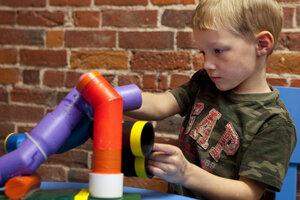Letting kids play: celebrating low-tech toys
Low-tech toys can be overshadowed by the razzle-dazzle of the electronic toy industry, but that doesn't mean all parents have forgotten the joys – and educational benefits – of a cardboard box and some string.

Low-tech toys can be overshadowed by the razzle-dazzle of the electronic toy industry, but not all parents have forgotten the joys of open-ended play. At the Boston Children's Museum Alex Shireman, 4, plays with a toy a MIT lab created to study how kids play and learn.
Melanie Stetson Freeman/The Christian Science Monitor
Last January Wired Magazine ran a story on the Five Best Toys of All Time. Which toys did the high-tech, gadget-and-gizmo friendly magazine (or at least the Geek Dad section name as the best? The stick, the box, string, the cardboard tube, and dirt. Not an electronic toy in the bunch. And, even more, all of these are simple, available (if not free), and provide open-ended play. Two are found in nature.
The internet went nuts with this story, as person after person — parents, teachers, nature advocates, play experts, and people who simply sense that today’s children grow up too quickly — passed this story around. With all the holiday advertising and shopping, and all the craze for the flashiest and the latest, a writer was advocating that kids go play in the dirt.
When Anna was small, I noticed that she was happy for hours with simple things — dirt, water, grass, a tire swing, paper, scissors, glue. She spent about a year being fascinated with adhesive tape — pulling, cutting and laying it down on paper, creating cardboard box-and-tube cameras and “candy machines”. She didn’t seem to need or want anything more expensive, complicated or “educational” than that. I’ve found this is often the case if we slow down, adjust our ideas about what is normal or expected, and let our children and our own instincts guide us.
On the heels of the Wired story came another one: The Center for Early Childhood Education at Eastern Connecticut State University released the results of its 2011 TIMPANI (Toy to Inspire Mindful Play and Nurture Imagination) study. Each year they name a “best toy” based on three categories: thinking and learning; cooperation and social interaction; and self-expression and imagination.
This year’s winner? The nearly 100-year-old Tinkertoy Construction Set. Said the study’s principal researcher, “Basic, open-ended toys tend to be more beneficial to children’s play and learning than some of the more elaborate and commercial toys that are on the market.” The Tinkertoy designers, after all, created their toy after seeing children play imaginatively with pencils and empty spools of thread.
The article goes on to point out that open-ended toys foster cooperation and communication, with peers as well as with parents:
"Through play, you can provide your child with the support needed to learn and grow, to learn how to learn, and to get needs met in safe, appropriate ways."
I’ve often bonded through play and creating with my family, and I’ve seen scores of children be happier and more engaged when playing with open-ended toys.
The Christian Science Monitor has assembled a diverse group of the best family and parenting bloggers out there. Our contributing and guest bloggers are not employed or directed by the Monitor, and the views expressed are the bloggers' own, as is responsibility for the content of their blogs. Susan Sachs Lipman blogs at Slow Family Online.

